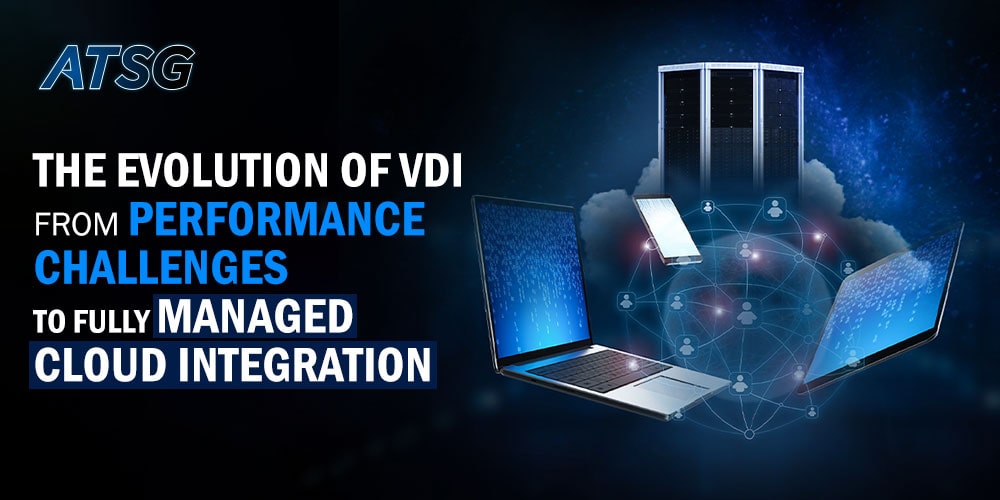In a remarkably short span of time, the advent of a Cloud-first strategy has wielded a revolutionary influence across several industries. It is one transformation that is absolutely hard to ignore, regardless of the industry or size of an organization.
And perhaps what’s most intriguing is the imminent transformation of end-user computing (EUC). As we witness on-premise data centers shutting down, either due to exorbitant overheads or obsolescence, many enterprises are now embarking on a journey that explores viable alternatives.
Amidst all this, Cloud is becoming the focal point of this migration. Within this landscape, on-premise Virtual Desktop Infrastructure (VDI) and Cloud Computing solutions have assumed pivotal roles, offering the promise of a dynamic and scalable future.

In this blog, we delve deep into the fascinating evolution of VDI, tracing its journey from the performance challenges of yesteryears, to its present state of seamless Cloud integrations.
The Evolution of Virtual Desktop Infrastructure (VDI)
As we talk about VDI evolution, we see that it has been quite remarkable. Initially, it grappled with significant challenges related to hardware limitations and performance issues. These VDI performance challenges often resulted in less-than-ideal user experiences, coupled with higher costs.
Also, the initial struggle with hardware limitations meant substantial capital investment (CapEx), to procure and maintain powerful servers and storage systems in-house, significantly increasing costs. Moreover, performance issues required on-going infrastructure upgrades, adding to the financial burden.
Fast forward to today, and VDI has undergone a significant transformation. VDI and hypervisors have played a pivotal role in shaping the modern state of virtualization. Also, the advent of hyper-converged infrastructure (HCI) has effectively addressed past performance concerns, making those issues a thing of the past.
One of the most note-worthy developments is the integration of VDI with Cloud technologies. This integration of VDI and public Clouds has given VDI a substantial boost, making it versatile and adaptable.
Looking further ahead in this evolutionary journey, the emergence of Desktop as a Service (DaaS) promises even greater accessibility. Businesses of all sizes, particularly large scale enterprises, are benefiting from this pay-as-you-go model offered by Cloud Service Providers (CSPs). This way, they easily tap into VDI like capabilities, without the hassle of investing in their own data centers.
The Revolution of Cloud-Based Management
Keeping up with the theme of this blog, which is the evolution of VDI, one stand-out milestone is the Cloud-based management revolution, led by the Cloud-Based Management Plane. This transformative shift in VDI operations has brought about a profound transformation in how businesses look towards their virtual desktop environments.
Back in the days, VDI updates and deployment often used to be extremely cumbersome and resource-intensive for IT teams. They constantly had to grapple with a lot of moving parts, which made scaling and adapting to evolving business needs quite a challenge.
Today, virtual desktop deployment and updates are relatively more streamlined. Enterprises now possess the ability to execute updates promptly and efficiently, all thanks to the simplified management offered by Cloud-based solutions.
How is the Cloud Re-shaping Modern VDI Trends?
As we look towards the future trends of VDI market growth, things look optimistic. According to a recent projection by Gartner®, the collective spending on public cloud services, encompassing Infrastructure as a Service (IaaS) and Platform as a Service (PaaS), is anticipated to surpass the US $180 billion threshold, by the end of 2023.
This substantial financial commitment signals a profound shift in the way organizations operate, particularly in their adoption of Cloud technologies. However, this transformation also raises important questions about the future of virtual desktop infrastructure (VDI).
In light of these developments, many businesses are contemplating the fate of their existing VDI deployments. The journey ahead seems to offer an exciting and viable alternative; the adoption of fully managed Desktop as a Service (DaaS) solutions.
Many businesses are now embracing DaaS, due to its convenience and simplified management. This choice however, hinges on the unique requirements and business strategy of each organization.
Notably, many VDI vendors have also been proactive in adapting to this changing environment. They have recognized the importance of seamless integration, spanning from VDI hardware sizing to VDI storage integration, and even extending to collaboration with the Cloud. These integrations have brought about a lot of benefits for businesses.
ATSG’s DaaS Solutions – A Better Alternative
For businesses in search of a more streamlined and cost-effective virtual desktop solution, ATSG presents an exciting alternative to traditional on-premise VDI. With our DaaS offering, ATSG has completely re-defined efficiency and ease of management. Now, it is easier than ever to manage your virtual desktop environment.
The DaaS solutions offered by ATSG are meticulously designed to not only enhance effectiveness, but also boost operational efficiency. This allows businesses to get rid of the complexities of on-premise VDI. ATSG’s DaaS offerings come with a hassle-free transition, where 24/7/365 support over multiple channels is available at every step. Furthermore, our scalable approach ensures that the virtual desktop environment of your business can scale up or down, with your evolving needs.
Conclusion
The journey of Virtual Desktop Infrastructure (VDI) evolution has un-deniably been quite transformative, addressing many performance challenges along the way. However, as enterprises navigate the dynamic landscape of desktop virtualization, Cloud-based Desktop as a Service (DaaS) solutions emerge as a far superior alternative, hands down. DaaS solutions align perfectly with the modern era of Cloud integration, and give businesses the ability to thrive and succeed, even in challenging environments.
ATSG’s un-wavering dedication to innovation reflects in our ATSGOne Cloud Manager, that is designed to streamline, optimize and simplify the management of your DaaS environment, from a single and intuitive orchestration portal.
ATSG has also been recognized as a Challenger in the inaugural 2023 Gartner® Magic Quadrant™ for Desktop as a Service (DaaS). We believe this achievement affirms the effectiveness of our Digital Workspace solution, positioning your enterprise for rapid digital transformation.
Get in touch with ATSG for top-notch managed IT services, Technology, Cybersecurity and Cloud Computing solutions for your enterprise.




